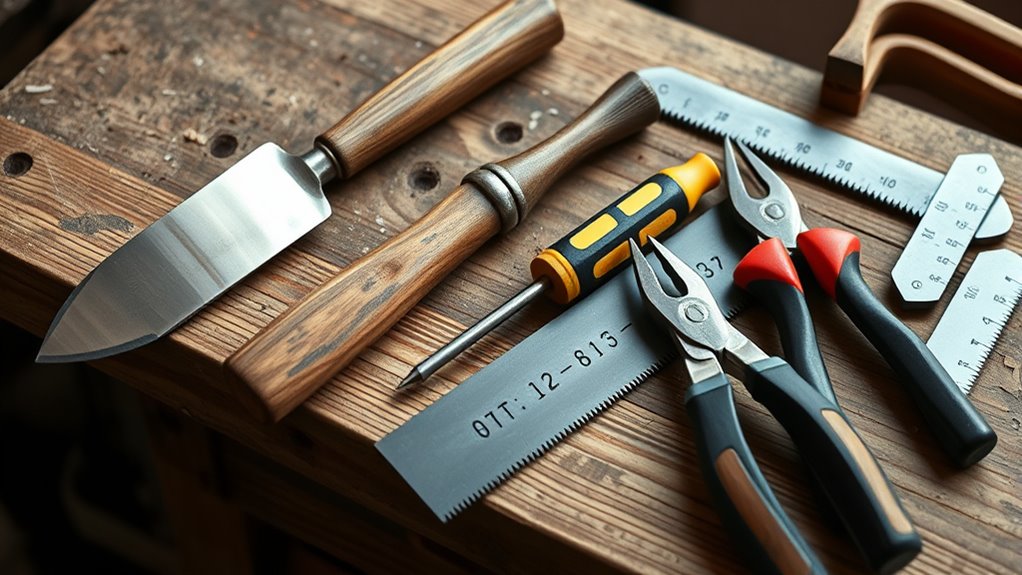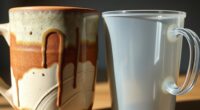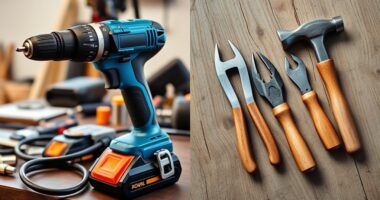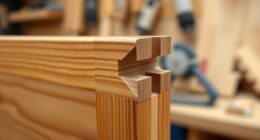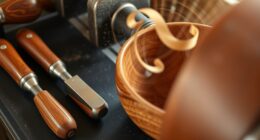To start your woodworking journey, you’ll need essential tools like a reliable tape measure for precise measurements, a combination square for accurate angles, and sharp chisels for shaping wood. Add a Japanese pull saw for clean cuts, a block plane for smoothing surfaces, and sturdy mallets for assembly. Improve your skills with sharpening stones, and guarantee stability with a workbench and vice. Don’t forget safety glasses to protect your eyes—keep going to discover how these tools can elevate your projects.
Key Takeaways
- Essential measuring tools like combination squares and tape measures ensure accurate cuts and layouts.
- Quality chisels and saws are vital for shaping, cutting, and fine detailing in woodworking projects.
- Clamps and vises provide secure holding during assembly, gluing, and finishing tasks.
- Hand mallets and sharpening stones help with shaping, assembly, and maintaining tool edge sharpness.
- Safety equipment such as safety glasses is crucial for protecting against potential hazards during woodworking.
Tape Measure
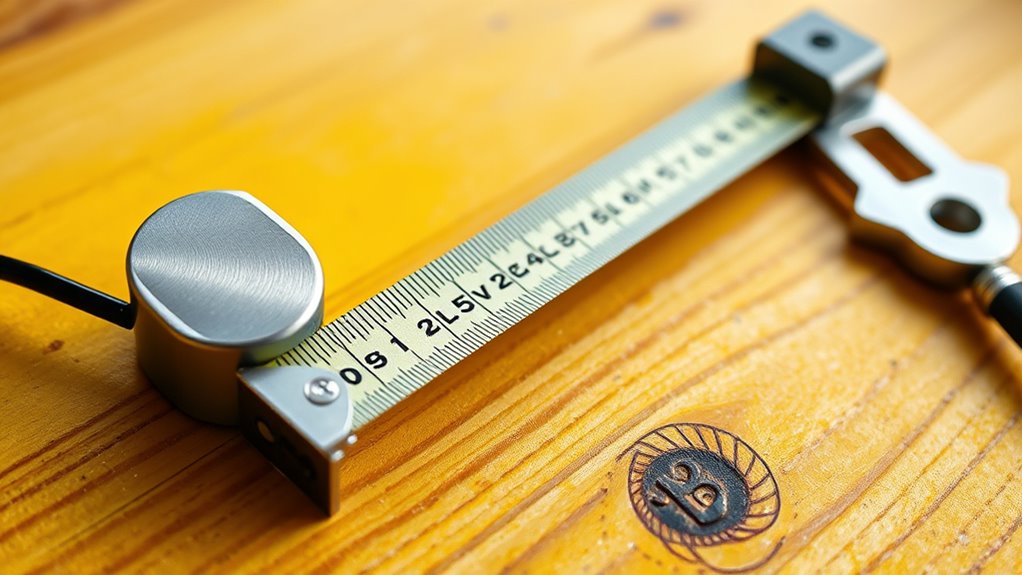
Have you ever wondered why accuracy matters so much in woodworking? It’s because precise measurements ensure your projects fit perfectly and look professional. When choosing a tape measure, prioritize accuracy—measuring from the 1-inch mark instead of the hook increases reliability, as long as you add that inch back to your final figure.
Keep in mind, hooks can bend or wear over time, so testing your tape periodically helps maintain precision. Using your tape to set up machines or mark layouts demonstrates its importance in every stage of your work. Recognizing the significance of industry trends can also inspire confidence and guidance during your woodworking projects. Additionally, staying updated on tool innovations can help you select the most reliable measuring tools for your needs. Paying attention to essential tool maintenance can further extend the lifespan and accuracy of your measuring tools. As technology advances, integrating smart measuring tools can enhance precision and efficiency in your workshop.
Combination Square

A combination square is a versatile tool that enhances accuracy in woodworking by providing multiple measurement and layout functions in one device. It guarantees the integrity of 90° angles and measures 45° angles for miter cuts and bevels. You can also locate the center of circular objects, making marking precise and efficient. It’s ideal for measuring depth and distances, aiding in layout tasks. Additionally, some models incorporate diverse designs that can improve your workflow by offering ergonomic features and durable materials. In setup, it helps align miter-gauge slots parallel to the saw blade, adjust rip fences, and set router or blade heights accurately. Unlike a tape measure, it offers more precise markings and allows you to draw parallel and perpendicular lines easily. Regular calibration and cleaning keep it accurate, and choosing a durable model will serve you well through many projects.
Chisels
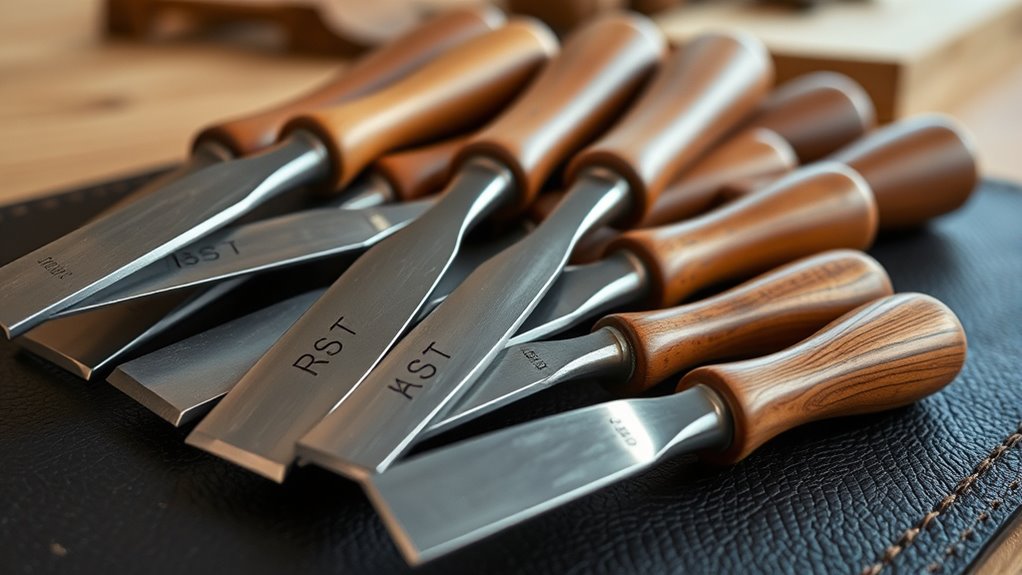
Are you familiar with the essential role chisels play in woodworking? These versatile tools come in various types, each suited for specific tasks.
Bench chisels are your go-to for general chopping, trimming, and shaping. Mortise chisels, with their thick blades, are designed to cut deep, square holes for joinery. Proper maintenance of these tools is vital to ensure their longevity and performance. Regular care, including honing and cleaning, helps maintain their cutting edge and prevents corrosion.
Paring chisels excel at delicate, precise shaving work, perfect for fitting joints and smoothing surfaces. Firmer chisels are heavier and ideal for heavy-duty chopping and shaping, especially when used with a mallet.
Corner chisels, with their V-shaped blades, help clean out tight corners in mortises.
High-quality chisels feature hardened steel blades for durability, with handles made from hardwood for comfort. Sharpening techniques and proper maintenance keep your chisels performing their best.
Japanese Pull Saw
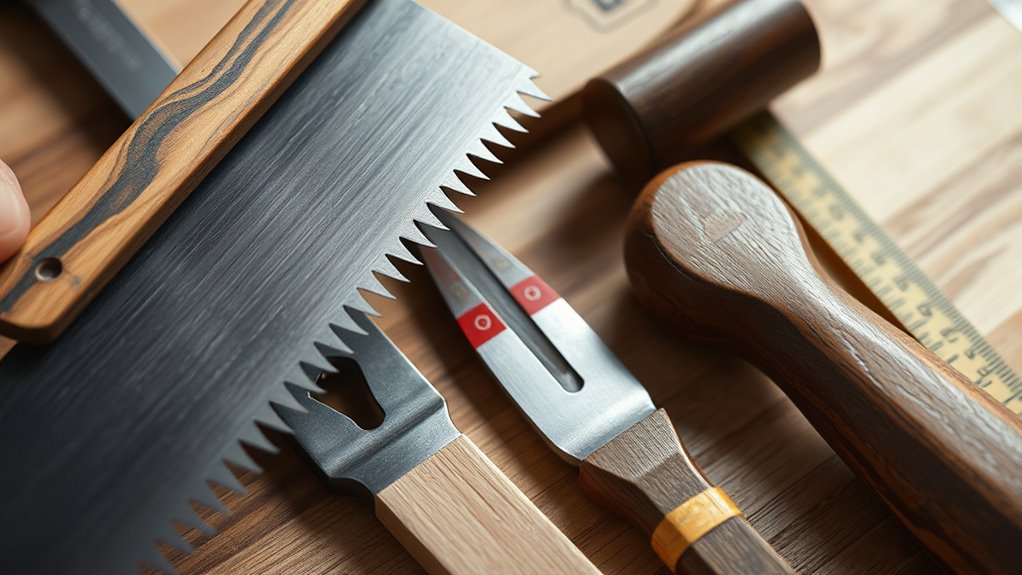
Japanese pull saws stand out for their unique design, featuring a thin, flexible blade that cuts on the pull stroke rather than the push. This design allows for precise, clean cuts with less material removal, producing a narrow kerf that minimizes wood waste and effort. The blade’s flexibility and tension during cutting keep it straight, offering excellent control, especially for delicate tasks like joinery. The teeth are finely set, optimized for smooth, accurate cuts, while the handle—often made from wood or composite—provides a comfortable grip. Variants like the Ryoba, with double edges, or the Dozuki, with reinforced spines, cater to different woodworking needs. Proper maintenance and understanding of retirement planning can ensure your tools and investments are protected for the long term. Additionally, selecting the right tuning tools can significantly improve your woodworking precision and efficiency.
Block Plane
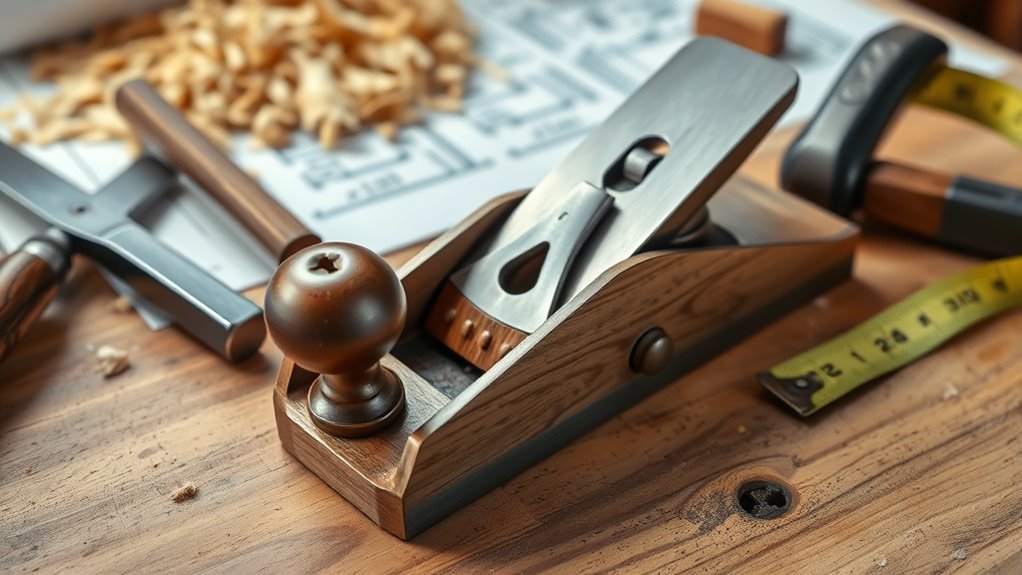
Ever wondered how to achieve fine, precise surface finishes on small or detailed woodworking projects? A block plane is your go-to tool. Its small, compact body allows for one-handed use and easy maneuverability, perfect for detailed work.
The blade is set at a shallow bed angle, around 12 to 20 degrees, enhancing efficiency when planing end grain. Its low-angle blade orientation makes slicing through tough fibers smoother. Using a block plane regularly can also help maintain the sharpness and effectiveness of the blade, ensuring consistent results. Incorporating regular maintenance practices extends the lifespan of your tool and maintains optimal performance.
The compact sole fits curves well, making it versatile for shaping and finishing. Often fitted with a cambered blade, it offers light, controlled cuts that prevent damage to delicate surfaces like veneers. Proper tool maintenance is essential to keep the blade sharp and the tool functioning optimally. Additionally, routinely checking and adjusting the blade angle can improve cutting efficiency and overall results. Proper blade sharpening techniques further enhance the tool’s performance and durability.
Use it to clean up joints, chamfer edges, remove glue lines, or mill small parts with precision. Its ease of handling makes it indispensable for fine woodworking tasks. Additionally, understanding proper tool maintenance ensures the block plane remains sharp and effective for detailed work.
Clamps
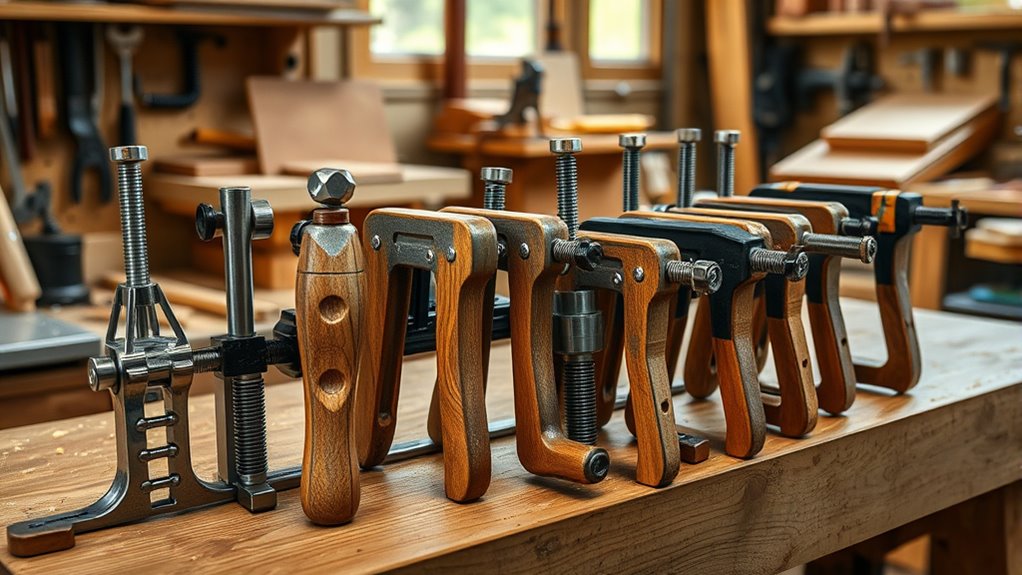
Clamps are essential tools in woodworking, providing the necessary pressure to hold pieces securely during gluing, assembly, or finishing. Different types serve specific functions: parallel jaw clamps keep panels flat without warping, while spring clamps are perfect for small projects and quick tasks. Using a high-quality airless paint sprayer can also improve efficiency and finish quality in painting projects. Bar clamps and pipe clamps handle larger projects, offering broad and adjustable pressure. F-style clamps deliver strong force for joinery, and face clamps apply pressure across surfaces, ideal for furniture building. Trigger and ratcheting clamps allow one-handed operation and precise control, whereas corner and panel clamps help align and assemble frames or panels evenly. Accessories like padded jaws and quick-release mechanisms enhance performance and protect your workpieces, making clamps versatile and indispensable for a wide range of woodworking tasks. Incorporating clamp accessories such as swivel pads or additional spreaders can further improve their versatility and adaptability for different projects. Additionally, selecting the right wall organization system can help keep your workspace tidy and efficient, ensuring all your clamps and tools are easily accessible when needed. Proper storage solutions also support workspace safety by reducing clutter and preventing accidents.
Mallets
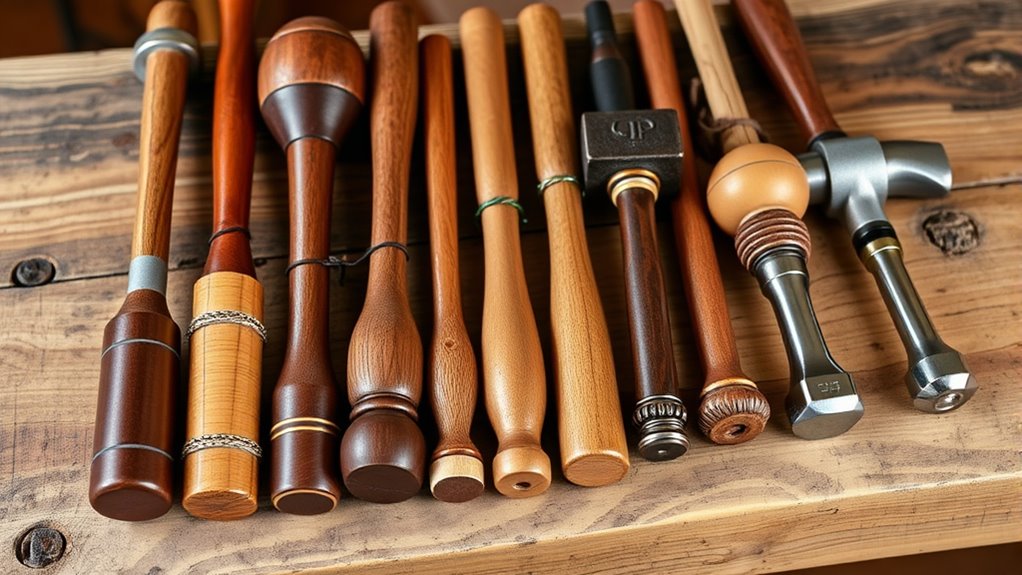
Mallets are versatile hand tools that come in various types, each designed for specific woodworking tasks. Joiner’s mallets feature a large rectangular head, often made with end grain facing outward for durability and to prevent denting. They’re perfect for heavy chisel work and joinery assembly. Carving mallets have round, dense heads, ideal for driving gouges and shaping wood in detailed carving. Rubber mallets have soft heads that prevent surface marring, making them suitable for furniture assembly or delicate tapping. Plastic mallets, often made from nylon or polyurethane, offer durability and softness, useful in metalworking or automotive tasks. Dead blow mallets, with hollow heads filled with shot, minimize rebound for controlled strikes, especially in precise metal or automotive work. Proper selection of mallet types can significantly improve the quality and efficiency of your woodworking projects. Choosing the right mallet depends on your specific project needs.
Sharpening Stones
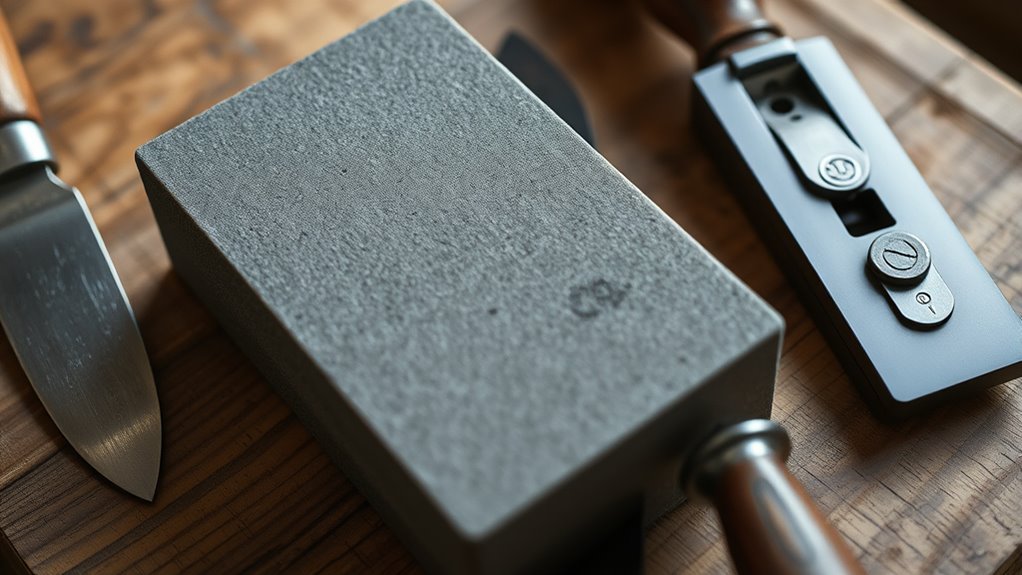
Sharpening stones are fundamental tools that help woodworkers maintain the cutting edges of their tools with precision. Water stones cut quickly and come in a wide range of grits, making them ideal for both dull and finely honed edges. They require water as a lubricant, which keeps the process clean and straightforward.
Diamond stones are durable, never need flattening, and can sharpen all types of tools, including carbide-tipped bits. They’re low maintenance—just wet before use and dry afterward.
Water stones wear faster and need periodic flattening, but they produce polished, sharp edges. Choosing the right stone depends on your tool condition and preference for maintenance.
Popular brands like DMT, Shapton, and Tormek offer reliable options for every woodworking need.
Workbench With Vise
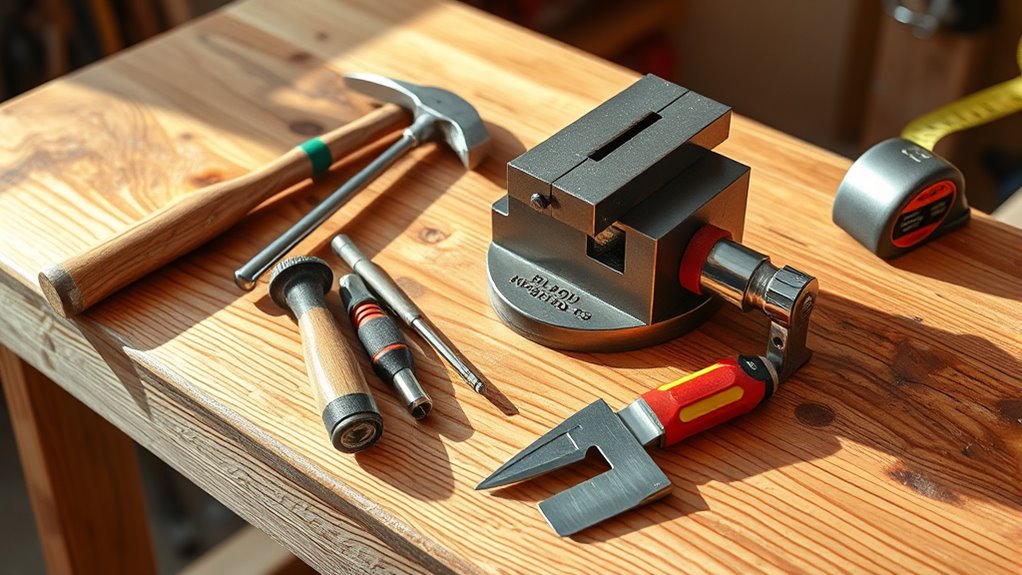
A workbench with a vise is an essential centerpiece in any woodworking shop, providing a stable platform for a variety of tasks. You can choose between solid wood or metal construction, depending on your workload and preference.
The right vise type—such as a leg, quick-release, or end vise—enhances functionality, with robust hardware like quick-release mechanisms ensuring secure, efficient clamping.
A well-designed workbench often includes shelves or drawers for storage, keeping tools organized and within reach. Installing the vise securely at the appropriate height maximizes stability.
Regular maintenance, including cleaning and lubricating moving parts, keeps it functioning smoothly.
Whether you opt for cast iron vises from trusted brands like Milwaukee or build a custom setup, a sturdy workbench with a vise boosts your efficiency and precision in woodworking.
Safety Glasses

A sturdy workbench with a vise keeps your projects stable, but safeguarding your eyes is just as important for a safe woodworking environment. Safety glasses come in various lens types like clear, tinted, polarized, and anti-fog, tailored to different tasks.
A sturdy workbench is essential, but protecting your eyes is equally crucial for safe woodworking.
Semi-rimless frames provide a good balance of protection and wide vision, while wraparound designs shield your eyes from debris and dust. Impact-resistant polycarbonate lenses withstand high-velocity chips and sawdust.
Some glasses feature UV protection for outdoor work. Polarized lenses reduce glare, and anti-fog coatings keep your view clear in humid conditions.
Look for safety glasses meeting ANSI Z87.1 standards for impact resistance and protection. Adjustable, lightweight frames with ventilation ensure comfort during long sessions, keeping your eyes safe without sacrificing visibility.
Frequently Asked Questions
How Do I Choose the Right Size of Chisel for Woodworking?
When choosing the right chisel size, consider the type of work you’ll do. Smaller chisels (1/4” to 1/2”) excel at fine detail and mortising.
Larger ones (3/4” and above) handle wider cuts and surface flattening. Match the chisel to the wood thickness and joint needs, starting with a basic set of 1/4”, 3/8”, 1/2”, and 3/4”.
This range covers most beginner to intermediate projects effectively.
What Is the Best Method to Maintain and Sharpen My Hand Saw?
Imagine slicing through wood as smooth as glass—that’s what proper saw maintenance and sharpening can do! You should clean your blade thoroughly after each use, keep it dry, and inspect teeth regularly.
Use a triangular file to sharpen each tooth with consistent pressure and angle. Secure the saw in a vise, apply even strokes, and set the teeth afterward.
Regular care guarantees your saw performs like a dream every single time.
How Do I Prevent My Tape Measure From Stretching or Breaking?
To prevent your tape measure from stretching or breaking, handle it carefully and avoid overextending beyond its limits. Apply steady pressure when measuring, and support the tape on surfaces to reduce sagging.
Retract the blade slowly to avoid damage, and store it in a cool, dry environment to prevent wear. Regularly inspect for damage, and don’t force the tape if it resists retraction, as this can cause breakage.
What Are the Key Safety Tips When Using a Japanese Pull Saw?
Safety starts with smart practices when using a Japanese pull saw. Protect your peepers with goggles, and keep your hands safe by maintaining a firm grip, fingers away from the blade.
Guarantee your workspace is clutter-free and stable to stay secure. Regularly inspect and maintain the saw, sharpening it when needed.
Follow proper techniques, pulling smoothly and at the correct angle, and avoid distractions for a safe, satisfying sawing session.
How Should I Store My Sharpening Stones for Optimal Use?
To store your sharpening stones ideally, you should keep them in a dry, stable environment away from extreme temperatures and dust.
Use tailored storage boxes with compartments or dividers to prevent chipping and guarantee flatness.
Clean and dry stones thoroughly before storing, and separate them to avoid damage.
Label your storage to quickly find the right grit, and keep frequently used stones within easy reach for convenience.
Conclusion
Having these top 10 hand tools will transform your woodworking experience. Did you know that over 60% of woodworkers say quality tools boost their precision and confidence? With the right tools like a tape measure, chisels, and a workbench, you’ll craft better projects faster. Invest in these essentials, and you’ll enjoy safer, more accurate, and satisfying woodworking sessions. Start building your toolkit today and watch your skills grow!
